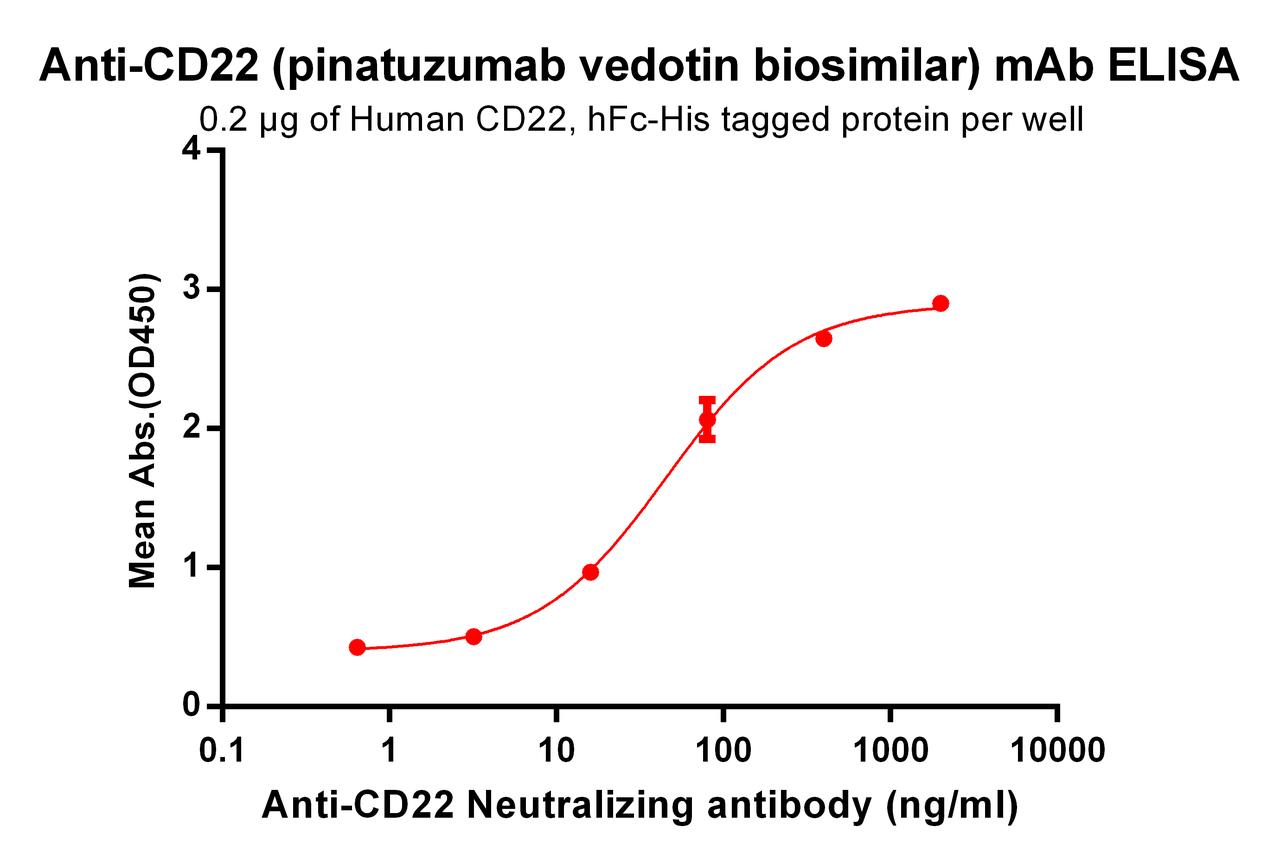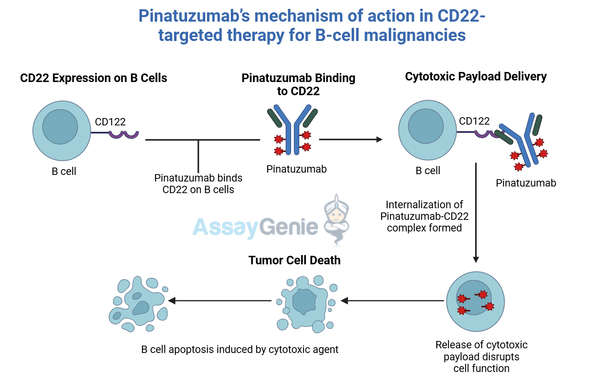Pinatuzumab: Advancing Cancer Research and Therapeutics
Quick Facts About Pinatuzumab
What is Pinatuzumab?
Pinatuzumab is an antibody-drug conjugate (ADC) designed to target CD22, a protein highly expressed on B-cell malignancies, including non-Hodgkin lymphoma (NHL).
What is the mechanism of action for Pinatuzumab?
It delivers cytotoxic agents directly to cancer cells by binding to CD22, resulting in targeted cell death while sparing healthy tissues.
What are the clinical applications of Pinatuzumab?
Pinatuzumab has been explored in clinical trials for treating B-cell lymphomas and other hematologic malignancies.
Is Pinatuzumab still in use?
While specific trials have concluded, Pinatuzumab’s foundational research continues to inform ADC development.
1.) Understanding Pinatuzumab
Pinatuzumab represents a significant advancement in cancer therapeutics as an antibody-drug conjugate (ADC), a treatment strategy that combines the specificity of monoclonal antibodies with the potent cytotoxic effects of chemotherapy. By specifically targeting CD22, Pinatuzumab exemplifies precision medicine, where treatments are tailored to focus on molecular targets unique to specific cancer types. This approach not only minimizes systemic toxicity but also enhances therapeutic efficacy, providing an alternative to traditional chemotherapies that often affect both cancerous and healthy cells alike.
CD22 is a transmembrane glycoprotein predominantly expressed on the surface of B cells, making it an ideal target for treating B-cell malignancies, including diffuse large B-cell lymphoma (DLBCL) and follicular lymphoma. Pinatuzumab binds to CD22 on these cancerous B cells, delivering a potent cytotoxic payload that induces cell death and disrupts tumor progression. This targeted action helps to preserve surrounding healthy tissue, a key advantage over conventional treatments.
Though Pinatuzumab Vedotin (a vedotin-conjugated version) was discontinued due to shifting research priorities, the foundational insights it provided into ADC technology remain integral. Emerging therapies continue to build upon the mechanism of Pinatuzumab, advancing the development of targeted cancer treatments. As research into ADCs progresses, Pinatuzumab's contributions to the understanding of targeted therapies play a crucial role in expanding the arsenal of tools available for treating B-cell malignancies and beyond.
2.) Mechanism of Action of Pinatuzumab
Pinatuzumab's mechanism of action highlights the innovation behind antibody-drug conjugates (ADCs), a class of targeted therapies that combine the precision of monoclonal antibodies with the potent cytotoxicity of chemotherapy. Pinatuzumab functions through three key steps, making it a powerful tool in cancer treatment.
1. Target Recognition:
Pinatuzumab’s therapeutic efficacy begins with its specificity for CD22, a transmembrane protein highly expressed on the surface of malignant B cells. By binding to CD22, Pinatuzumab effectively targets cancerous B cells, minimizing the impact on healthy, non-target cells. This precise targeting mechanism is a hallmark of ADC technology, ensuring that the cytotoxic agent is delivered directly to the tumor.
2. Internalization:
After binding to CD22, the ADC-CD22 complex is internalized through endocytosis, a process where the cell membrane engulfs the antibody-drug conjugate and transports it into the cell. This step is essential for ensuring that the cytotoxic payload reaches its intended destination: inside the cancer cell, where it can exert its therapeutic effect.
3. Cytotoxic Release:
Once inside the cell, the conjugated cytotoxic drug is released, typically by proteolytic cleavage or other mechanisms. The cytotoxic agent interferes with critical cellular functions, such as DNA replication, leading to cell cycle arrest and ultimately apoptosis (programmed cell death). This disruption halts tumor growth and prevents further cancer cell proliferation.
Pinatuzumab’s targeted action reduces the off-target effects commonly seen with traditional chemotherapy, providing a more precise and effective treatment option. By overcoming the limitations of systemic chemotherapy, Pinatuzumab has influenced the development of next-generation ADCs, paving the way for more personalized and effective cancer therapies.
3.) Clinical Applications of Pinatuzumab
Pinatuzumab’s clinical applications have primarily focused on treating hematologic malignancies, particularly B-cell lymphomas, where it has demonstrated significant therapeutic potential. Its targeted mechanism of action, which focuses on the CD22 antigen expressed on malignant B cells, makes it a promising candidate for treating a range of blood cancers.
1. Diffuse Large B-Cell Lymphoma (DLBCL):
DLBCL, a highly aggressive form of non-Hodgkin lymphoma (NHL), presents substantial treatment challenges. Pinatuzumab has shown efficacy in targeting CD22-positive malignant B cells, leading to tumor regression and enhanced therapeutic outcomes in clinical trials. By selectively targeting the tumor cells, it offers an alternative to conventional treatments, which may be less specific and more toxic. Pinatuzumab has provided an effective option for patients with relapsed or refractory DLBCL, where other therapies often fail.
2. Follicular Lymphoma:
Pinatuzumab has also shown promise in treating follicular lymphoma, a less aggressive but often recurrent form of NHL. The targeted approach has contributed to prolonged remission periods in patients, offering a viable treatment for individuals who face repeated relapses. Its ability to specifically bind CD22-expressing malignant cells has provided a more personalized, effective approach to managing this type of lymphoma.
Although development of Pinatuzumab Vedotin has been discontinued, the clinical data gathered from its trials have greatly informed the broader field of antibody-drug conjugates (ADCs). These findings continue to guide the development of next-generation ADC therapies, emphasizing the ongoing need for innovative, targeted treatments in the fight against cancer.
4.) Exploring Biosimilars for Pinatuzumab
What is a Biosimilar?
Biosimilars are biologic medical products that are highly similar to an original reference product in terms of safety, purity, and potency. They play a crucial role in expanding access to biologic therapies and fostering research innovations.

| Pinatuzumab (Anti-CD22) Biosimilar Antibody | |
|---|---|
| Antibody Type: | Monoclonal Antibody |
| Protein: | CD22 |
| Reactivity: | Human |
Advancing Research on Pinatuzumab Biosimilars
Pinatuzumab biosimilars are emerging as valuable tools for researchers. These biosimilars enable:
- Cost-Effective Research: Providing affordable alternatives to original ADCs
- Expanded Applications: Supporting preclinical and clinical investigations into ADC mechanisms and new therapeutic combinations.
- Innovative Development: Facilitating the refinement of ADC technology by serving as benchmarks for newer agents.
Research Use Only Disclaimer
Discover Our Biosimilar Range
At Assay Genie, we specialize in providing high-quality biosimilars for research use! Check out our full biosimilar range to learn more.

By Marina Alberto, PhD
Marina Alberto, PhD, holds a robust academic background in Biotechnology, earning her Bachelor’s Degree and PhD in Science and Technology from Quilmes National University. Her research spans cancer immunotherapy, glycan profiling, and vaccine development, including innovative projects on pediatric leukemia diagnosis and cancer-associated carbohydrate-mimetic vaccines. She currently serves as a Technical Support and Sales Specialist at Assay Genie.
Recent Posts
-
Enavatuzumab: Revolutionizing Cancer Research Through Novel Therapeutics
Quick Facts About EnavatuzumabWhat is Enavatuzumab?Enavatuzumab is a monoclonal antibo …17th Dec 2025 -
Alemtuzumab: Mechanism, Applications, and Biosimilar Advancements
Quick Facts About AlemtuzumabWhat is Alemtuzumab?Alemtuzumab is a monoclonal antibody …17th Dec 2025 -
Validation of MycoGenie Rapid Mycoplasma Detection Kit - A highly sensitive visual determination method for Mycoplasma detection.
The MycoGenie Rapid Mycoplasma Detection Kit enables the detection of 28 Mycoplasma sp …3rd Mar 2025




